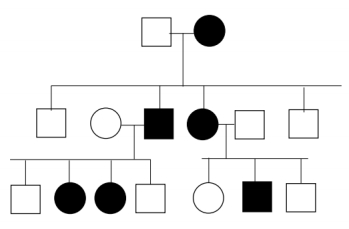In humans, the ability to bend the thumb back beyond vertical is called hitchhiker's thumb and is dominant to the inability to do so (OMIM 274200; see Problem 41). Also, the presence of attached earlobes is recessive to unattached earlobes (OMIM 128900).
Using all available and willing members of your family, or members of another family if yours is not easily accessible, trace the transmission of both traits in a pedigree. Use allelic symbols H and h for the thumb and E and e for earlobes, and identify the genotypes for each family member as completely as possible. Bring the pedigree back to share with your group.
Table of contents
- 1. Introduction to Genetics51m
- 2. Mendel's Laws of Inheritance3h 37m
- 3. Extensions to Mendelian Inheritance2h 41m
- 4. Genetic Mapping and Linkage2h 28m
- 5. Genetics of Bacteria and Viruses1h 21m
- 6. Chromosomal Variation1h 48m
- 7. DNA and Chromosome Structure56m
- 8. DNA Replication1h 10m
- 9. Mitosis and Meiosis1h 34m
- 10. Transcription1h 0m
- 11. Translation58m
- 12. Gene Regulation in Prokaryotes1h 19m
- 13. Gene Regulation in Eukaryotes44m
- 14. Genetic Control of Development44m
- 15. Genomes and Genomics1h 50m
- 16. Transposable Elements47m
- 17. Mutation, Repair, and Recombination1h 6m
- 18. Molecular Genetic Tools19m
- 19. Cancer Genetics29m
- 20. Quantitative Genetics1h 26m
- 21. Population Genetics50m
- 22. Evolutionary Genetics29m
2. Mendel's Laws of Inheritance
Pedigrees
Struggling with Genetics?
Join thousands of students who trust us to help them ace their exams!Watch the first videoMultiple Choice
This pedigree exhibits which of the following inheritance patterns?

A
Autosomal Dominant
B
X-linked Recessive Recessive
C
X-linked Dominant
D
Autosomal Polymorphism
 Verified step by step guidance
Verified step by step guidance1
Examine the pedigree chart to identify the pattern of inheritance. Look for whether the trait appears in every generation, which can indicate a dominant trait.
Check if both males and females are affected equally, which can suggest autosomal inheritance. If only one gender is predominantly affected, consider X-linked inheritance.
Observe if affected individuals have at least one affected parent, which is typical for dominant inheritance patterns.
Consider if the trait skips generations, which is more common in recessive inheritance patterns.
Analyze if affected fathers pass the trait to all their daughters but none of their sons, which is indicative of X-linked dominant inheritance.
Related Videos
Related Practice
Open Question




